What is a Software Development Tool?
A software development tool is like a trusty companion for developers throughout the software development lifecycle (SDLC). These tools play critical roles at various stages, assisting with everything from creating and modifying to testing and debugging. They help ensure that the software product you end up with is polished, functional, and ready to meet your needs.
11 Best Software Development Tools to Use in 2024
Here’s a curated list of the 11 best software development tools we recommend, including their costs, use cases, features, and what to watch out for:
1. Nifty: All-in-One Software Development Management Tool
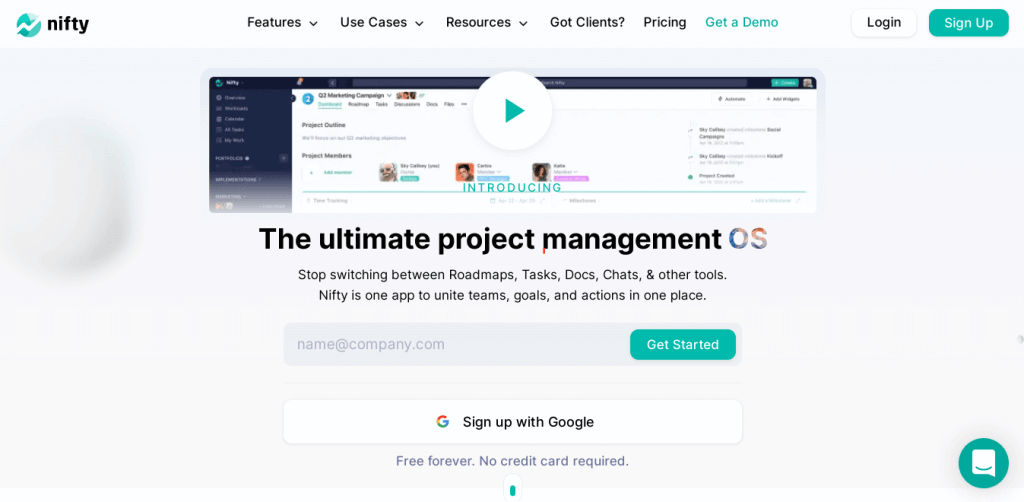
When it comes to project management for software development teams, Nifty stands out as an all-in-one solution that integrates agile workflows, team collaboration, and advanced project tracking features to modernize engineering workflows. Here’s why Nifty is the ultimate choice for development teams: it combines powerful features, real-time tracking, and a seamless user experience to support and scale efficient, innovative development processes.
Nifty brings together everything software development teams need for project management in one platform. It simplifies the development process with robust tools like Kanban boards and roadmaps to streamline workflows and automating progress tracking.
Why Nifty is Better Than Jira for Agile Teams
Nifty’s Milestone function is perfect for agile project planning, making it a compelling alternative to Jira. With color-coded milestone tracking, Nifty allows you to automate progress reports and updates, keeping you informed without manual effort.
| Feature | Nifty | Jira |
|---|---|---|
| Kanban & Roadmaps | Combined in one view | Separate, requiring toggling |
| Milestones & Progress Updates | Automated with task completion | Requires manual updates |
| Document Management | Centralized with real-time collaboration | Limited |
| Time Tracking | Built-in for tasks and projects | Requires integration |
| Cost | Affordable, All-in-One | Expensive with add-ons |
With Nifty’s roadmap view, tracking project phases has never been easier. Here’s a snapshot of how our roadmap looks in Nifty:

Key Features:
- Milestone-Based Roadmaps: Automate progress updates based on task completion to give real-time visibility into your team’s goals.
- Kanban Boards: Visualize workflows with an intuitive drag-and-drop interface.
- Team Collaboration: Centralize communication with real-time messaging and integrated document management.
- Time Tracking: Track billable hours and task durations for accurate project costing.
Seamless Team Collaboration with Nifty Docs
Nifty goes beyond project tracking by offering Nifty Docs, a real-time collaborative document management system. Teams can store and edit project-related documents in one place, eliminating the need for external tools. The user-friendly interface and formatting options make documentation and collaboration a breeze.
Nifty Docs Features:
- Centralized repository for all project documents
- Real-time collaboration
- Access from anywhere
- Seamless sharing and editing
Check out the Nifty Docs interface:
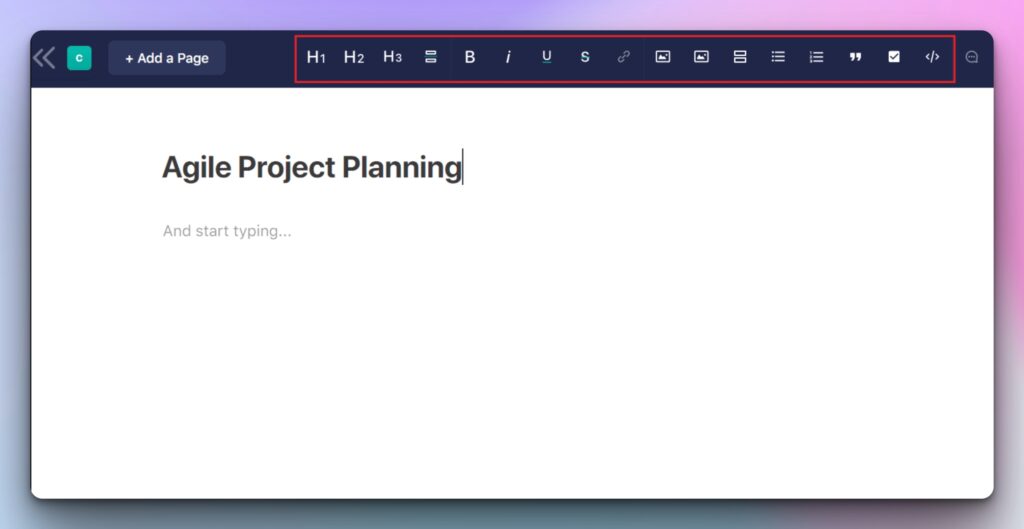
Advanced Time Tracking for Precise Project Management
Time management is crucial for software development teams, especially for tracking billable hours and team efficiency. Nifty’s built-in time tracking feature gives you detailed insights into how much time your team spends on each task, enabling better resource allocation and billing accuracy.
- Detailed time logs for every task
- Time tracking across multiple projects
- Exportable reports for tracking and billing
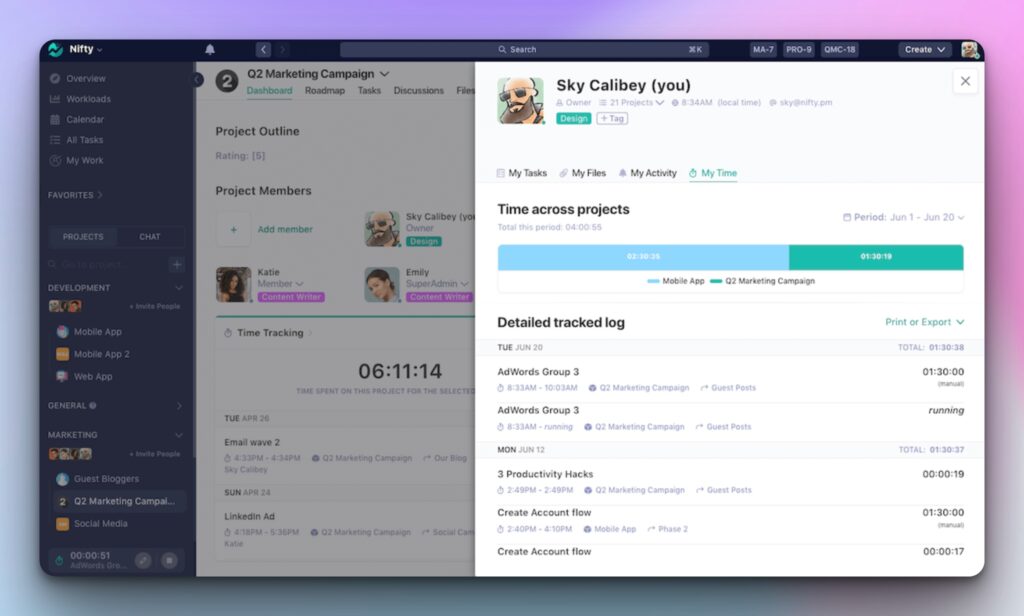
Real-Time Project Reporting and Dashboards
One of Nifty’s standout features is its ability to generate custom project reports. Nifty’s dashboards allow you to quickly view key project metrics, such as open tasks, resource allocation, and progress across different projects. This gives you the ability to spot inefficiencies and optimize processes.
- Customizable dashboard reports
- Real-time insights into team performance
- Instant access to project health metrics

Why Nifty Works Best for Agile Teams
Nifty does more than just task and project tracking—it empowers end-to-end agile project management with seamless team collaboration, automated progress tracking, and an intuitive user experience.
Key Stats:
- 35% faster project delivery with automated progress tracking
- 50% increase in team efficiency with built-in time tracking and resource management
- 70% reduction in tool costs due to all-in-one platform capabilities
Pricing
- Free plan for unlimited users
- Personal: $7/user/month
- Pro: $10/user/month
- Business: $16/user/month
👉 Ready to try Nifty? Get started for free.
Nifty best software development tool use cases:
Nifty is a top choice for agile software development teams due to its comprehensive capabilities, enabling teams to manage the entire development lifecycle. Here’s how you can leverage Nifty for your software development process:
1. Planning
Use Nifty as your Scrum Whiteboard to strategically plan and organize your software development process. From setting up sprints to defining goals, Nifty allows for seamless sprint planning.
2. Prioritizing
Easily assign priorities to various elements like ideas, feedback, product improvements, and backlogs, ensuring that your development focus aligns with team goals and user needs.
3. Roadmapping
Build your development roadmap by factoring in task priorities, dependencies, and timelines. Nifty’s roadmap and timeline features help you visualize your project from start to finish with automated progress tracking.
4. Documenting
Centralize your software documentation in one place. Collect and share crucial documents such as product requirements, scope, specifications, and deliverables, ensuring all stakeholders stay aligned and informed.
5. Collaborating
Host daily stand-ups or gather feedback from product owners, managers, and stakeholders in real time. With Nifty’s communication tools, your team can stay connected and collaborate effectively within the platform.
6. Managing
Run sprint cycles, assign tasks, and manage resources all within Nifty. You can also automate workflows, track time and task goals, and monitor KPIs to ensure that your project stays on track.
Nifty brings together everything your software development team needs—from planning to execution—making it one of the best tools for agile development and project management.
2. GitHub: For Community-Driven Software Development process
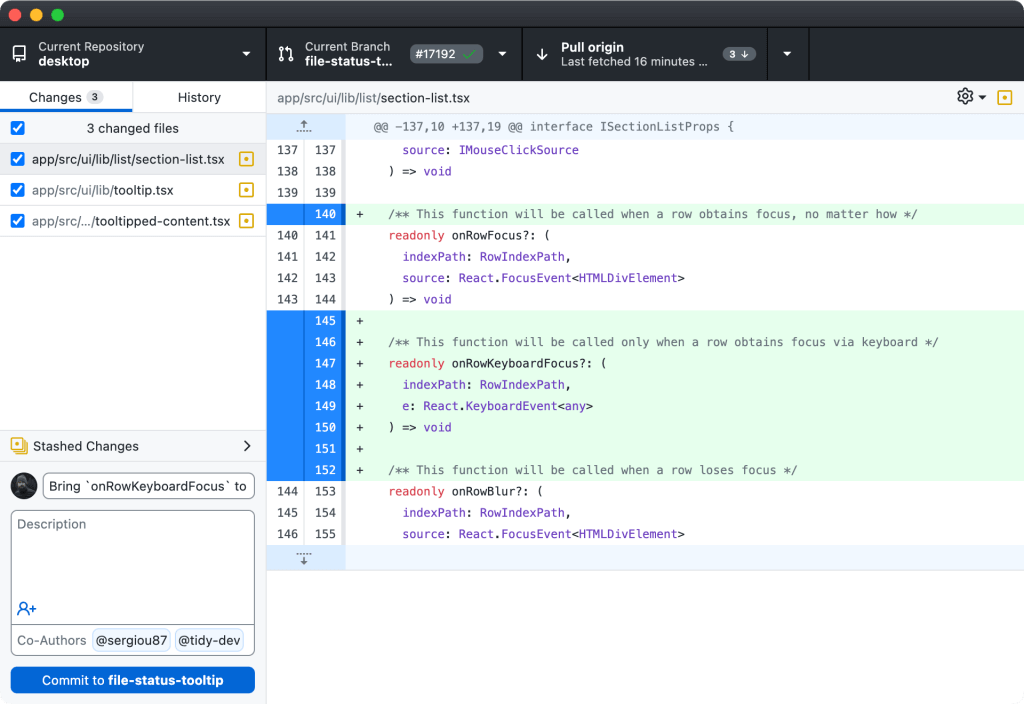
Git is an open-source, distributed version control system, and GitHub is one of the largest cloud-based Git repositories. Software developers use it to publish code, follow each other, do code reviews, peer codes, follow projects, and communicate with each other. Think of it as a social networking platform for developers!
Pricing
- Free: $0
- Team: $4 per user per month (billed annually)
- Enterprise: $21 per user per month (billed annually)
Use Cases
As a comprehensive code repository tool, GitHub allows users to manage projects, store code, build software, review other’s code, collaborate on code security, seek solutions, and pitch projects. It supports multiple programming languages and can be used directly within code editors like VSCode.
Key features
- Git-based version controlling to track changes to code.
- Collaborative coding to develop a community around a program or solution.
- Automation of various development processes, like planning, approvals, management, etc.
- Private repositories for sharing codes only with authorized users.
- Threat analysis to identify vulnerabilities before they become a nuisance.
- GitHub Marketplace for plug-and-play development tools or apps.
Pros
- Hosting a public repository is available for free.
- PullRequest allows developers to review, discuss, and merge changes to a code.
- Dependabot performs automatic vulnerability testing and updating versions.
- Offers diverse perspectives on a similar problem.
Cons
- CI/CD is a bit underwhelming.
- Difficulty in permanently deleting unwanted files and folders.
3. Jira: For Issue and Bug Tracking During Development
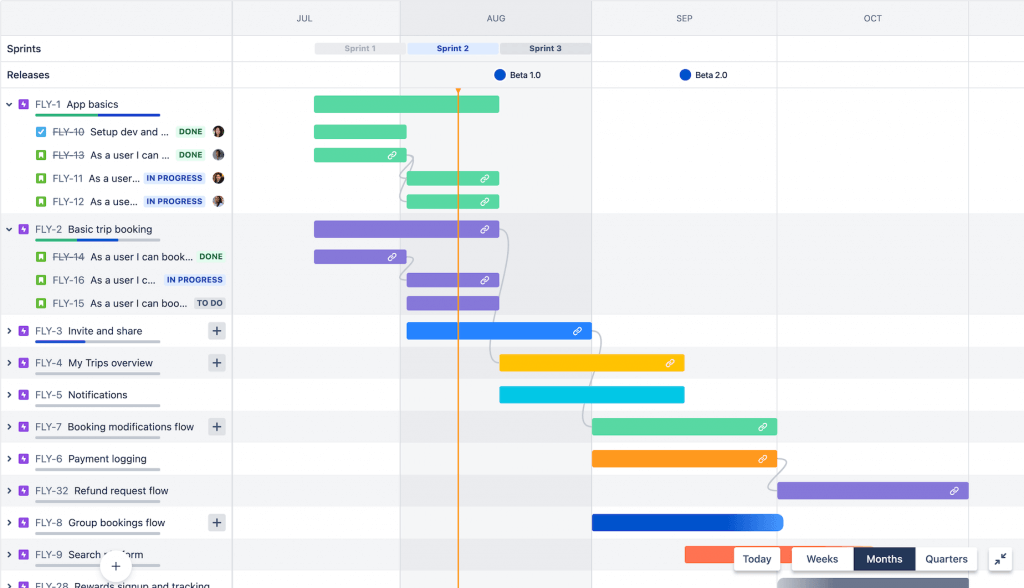
Jira is a subscription-based project management tool. It enjoys a solid reputation as an agile software development tool, primarily due to its issue and bug-tracking capabilities.
Additionally, its DevOps-oriented suite of cloud tools and services allows efficient tracking of backlogs, agile release status, bug resolution, security updates and patches, and more for software development teams.
Pricing
- Free: $0
- Standard: $7.75 per user (billed monthly)
- Premium: $15.25 per user (billed monthly)
- Enterprise: Custom
Use Cases
As mentioned, Jira is an excellent agile software development tool and must be used while following agile methodologies during software development.
Key features
- Interactive timelines for project road mapping and tracking.
- Project overview through agile boards (Scrum and Kanban).
- Backlog view to reprioritize tasks by importance and urgency.
- Custom workflows with access to importable templates in the Atlassian Marketplace.
- Rule-based automations.
Make the smart move; Choose Nifty over Jira.
Sign up for Nifty
Pros
- It is suitable for any kind of product development – software or otherwise.
- Seamless integration with a wide variety of third-party and Marketplace apps.
- Comes with RESTful API to push and pull data into Jira from other tools.
Cons
- High barrier to entry paired with a steep learning curve.
- An overly complicated user interface, which causes a trade-off in performance.
4. Bitbucket: Git Version Control System by Atlassian
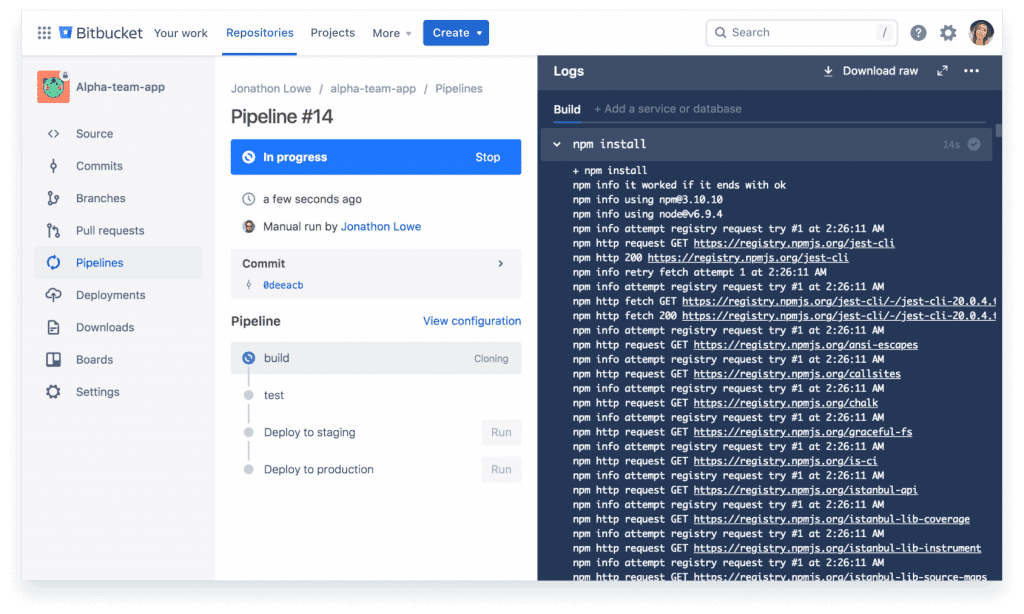
Bitbucket is essentially a dedicated GitHub for Jira users. It is a Git repository hosted by Atlassian and performs revision and version control. Like GitHub, Bitbucket offers the option to host or access a public repository for the free version and a private repository for the paid version. Software development teams can collaborate on code, pull requests, track bugs, and more.
Pricing
- Free: $0
- Standard: $3 per user
- Premium: $6 per user
Use Cases
Bitbucket is typically used as a source code repository and for a centralized version control system.
Key features
- Powerful commit-level review system that fetches updated code easily.
- Allows multiple code reviewers to work collaboratively.
- Supports Cloud, Server, and Data Center hosting.
- Use in-line comments and conversation threads for code-level discussions.
- Built-in issue tracker that can be configured using variables like milestone, version, etc.
Pros
- Integrated query management systems and bug-tracking tools.
- Compatibility with other DevOps and agile software development tools.
- Works with GitHub for code authentication and private repository management.
Cons
- It primarily focuses on Jira customers, which limits its scope and reach.
5. Cloud9 IDE: For Software Development in the AWS Environment
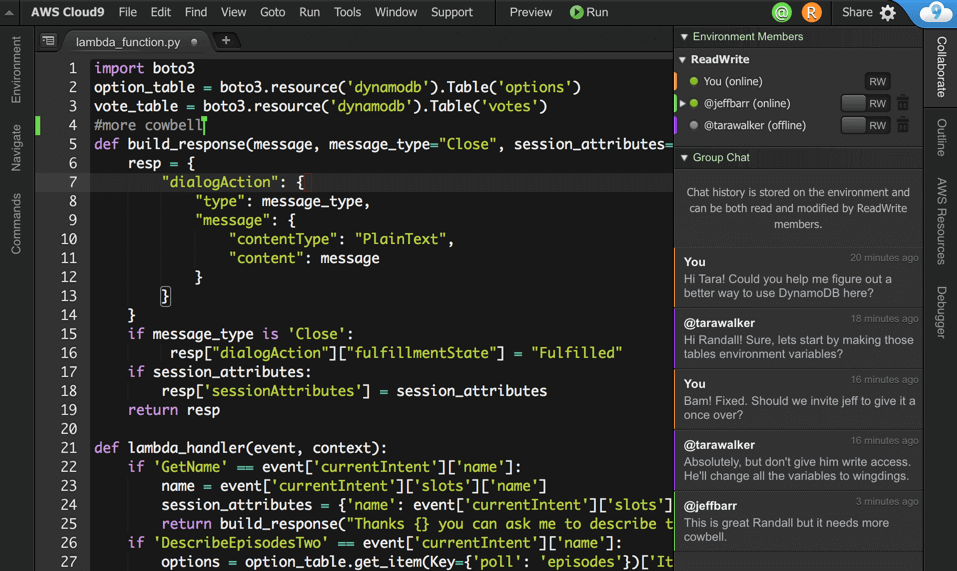
Cloud9 IDE or AWS Cloud9 is a cloud-based integrated development environment (IDE) backed by Amazon. This software development tool combines the Ubuntu workspace with an online code editor, allowing developers to write, run, and debug codes using just their browser. This IDE setup includes a code editor, debugger, and terminal, along with a pre-installed AWS Command Line Interface (CLI).
Pricing
Cloud9 has a pay-per-use policy where you only have to pay for the resources utilized while storing or running the code. You can connect with AWS specialists for a free trial and personalized quote.
Use Cases
Cloud9 IDE can be used for:
- Creating, running, and debugging codes in a Serverless Application Model (SAM).
- Software development in the AWS ecosystem and while using AWS services.
- Developing complex software products or working with disparate teams.
Key features
- Powerful browser-based editor to write, run, and debug codes.
- Built-in terminal with sudo privileges to Linux server.
- Cloud-based service that is accessible from anywhere.
- Supports more than 40 programming languages, including C, C++, JavaScript, PHP, Perl, Ruby, Node.js, and more.
- Serverless development tools with integrated software development kits, debugger, tools, and libraries.
- Code Completion suggestion and hinting makes software development quicker.
Pros
- Offers absolute freedom over the software development and testing environments.
- Compatible with almost all major programming languages.
- Bypasses the need for setting up, configuring, and maintaining individual development tools.
- Integration with AWS CodeStar enables the setting up of a continuous delivery toolchain for quick deployment.
Cons
- Project execution can be slow and even shut down in instances.
- UI looks obsolete and is difficult to navigate.
6. Bootstrap: Front-End Development Tool
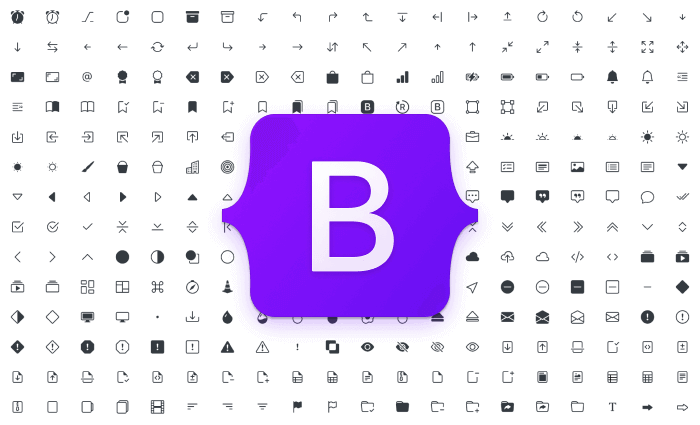
Bootstrap is the best software development tool for working with Java, Cascading Style Sheets (CSS), and HyperText Markup Language (HTML).
It is an open-source JavaScript library of reusable components to facilitate quick prototyping and production. Such a quality also makes it highly modular, extendable, and feature-rich. At the same time, this front-end toolkit helps create lightweight, responsive, and quick-loading websites.
Pricing
- Free: $0 (limited to 10 users)
- Pro: $15 per month (limited to 20 users)
- Enterprise: $29 per month (limited to 30 users)
Use Cases
Bootstrap is best used for:
- Client-side software development
- Developing cross-platform, cross-device software solutions
- Teams familiar with HTML and CSS
Key features
- Pre-built components that make development quick and painless.
- Contains an extensive list of components like drop-down menus, alert boxes, navigation bars, alerts, progress bars, etc.
- Sass variables to customize global CSS values in one go.
- Includes jQuery plugin library to incorporate advanced functionalities.
- Responsive utility classes for multi-screen displays.
Pros
- Mobile-first development grants the software application an edge.
- Bootstrap templates and themes are readily available online.
- Copious community support with ample resources.
Cons
- Lacks distinct customization capabilities.
- Clunky and heavyweight architecture that hinders performance.
More than 82 teams signed up or migrated to Nifty last week.
Be one of them
7. Node.js: Best Server-Side Software Development Tool
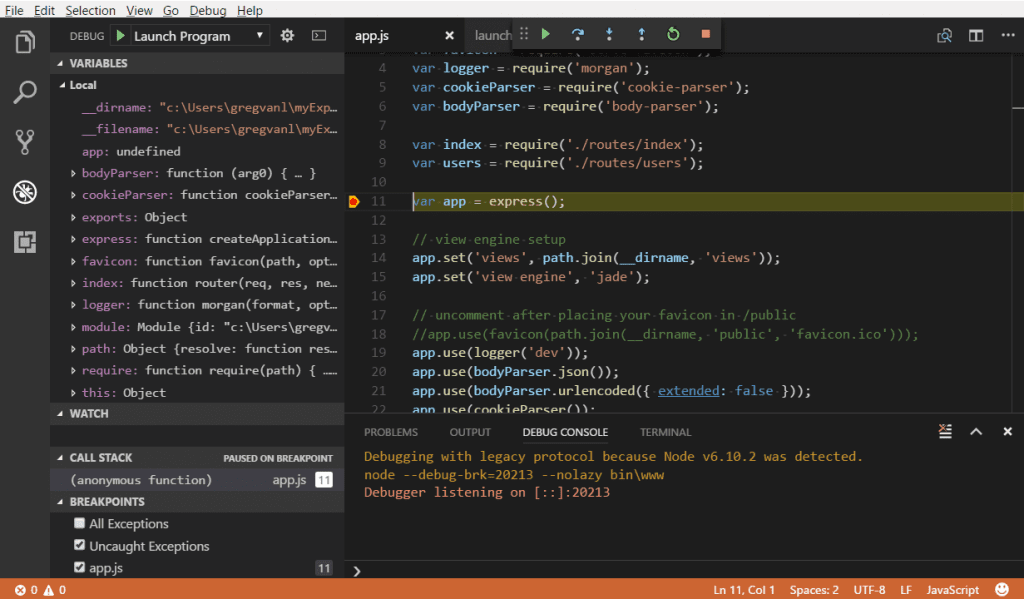
Node.js is an open-source, event-driven JavaScript runtime environment and library. Although it can be used for front-end and back-end development, it finds predominant use on the server side. Its asynchronous nature makes it possible to handle errors and run multiple tasks concurrently.
Pricing
Free and open-source.
Use Cases
You can use Node.js for:
- Developing streaming solutions, chatbots, and collaboration tools,
- Building real-time data applications like dashboards and Single Page Applications (SPAs),
- Creating solutions based on the microservice architecture.
Key features
- Contains a vast library of JavaScript modules for quicker development cycles.
- Asynchronicity Node.js applications to handle high volumes of requests.
- Single-thread request handling also ensures non-blocking of I/O operations.
- The single-thread, event-driven loop imparts high scalability.
- Generates self-sufficient and cross-platform executable codes.
Pros
- Efficient resource optimization saves time and money while speeding up software development.
- Supports application growth in horizontal and vertical orientations through the addition of nodes.
- Since most developers are proficient in JavaScript, they can comfortably use Node.js.
Cons
- Carries high technical debt, which brings down performance, especially during heavy computation.
- Takes up an inordinate amount of memory resulting in out-of-memory error.
8. Linx: Best Low-Code Software Development Tool
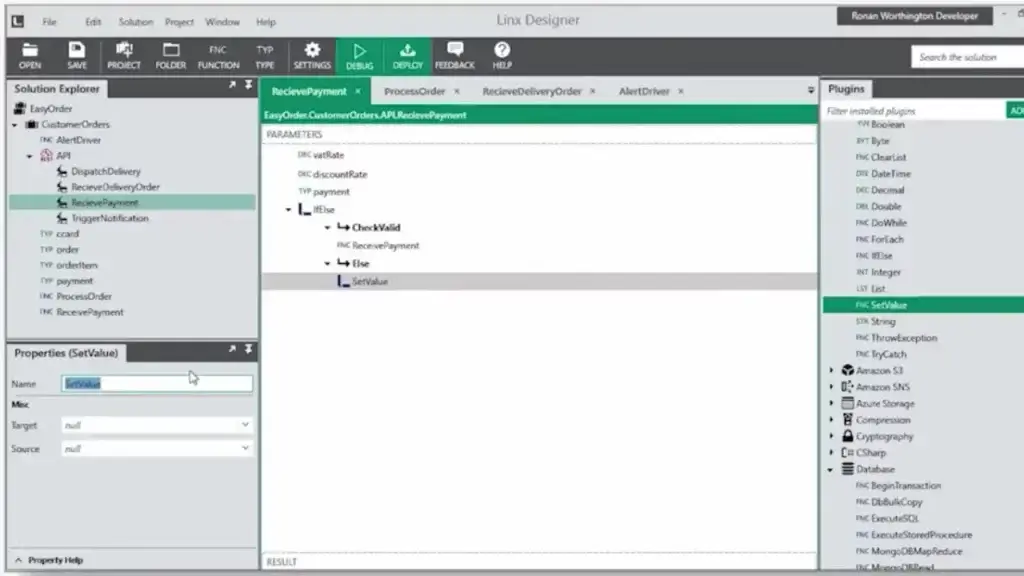
Our list of best software development tools will be incomplete without the mention of Linx. After all, no-code and low-code software development frameworks have triggered a wave of citizen developers by making software development accessible to all.
The Linx development platform comes with a Linx Designer (IDE), Plugins, and Server. Such a comprehensive software development tool helps develop customized, scalable, and robust backend solutions
Pricing
Cloud-Hosted Services
- Starter: $149 per month per server (billed monthly)
- Business: $299 per month per server (billed monthly)
- Enterprise: $599 per month per server (billed monthly)
Self-Hosted Services:
- 3 Solutions: $599 per month (billed annually)
- 9 Solutions: $1,399 per month (billed annually)
- 20 Solutions: $2,599 per month (billed annually)
- 40 Solutions: $4,999 per month (billed annually)
Use Cases
Linx can be used for:
- System consolidation through integration
- Business process automation
- Low-code development
Key features
- Low-code implementation of backend logic and process automation.
- Integration of dissimilar systems to supercharge developer productivity.
- APIs to enable communication between disparate systems.
- One-click deployment on-premise, in the cloud, or both.
- 100+ built-in programming functions, services, actions, and automations.
Pros
- Interactive and easy-to-use interface with drag-and-drop functionality.
- Adding plugins or features and extending API capabilities is easy.
- Supports rapid build and quick deployment.
Cons
- Lacks the ability to import project files from other commonly used IDEs.
- Has a steep learning curve.
9. Vim: Powerful Text Based Software Development Tool
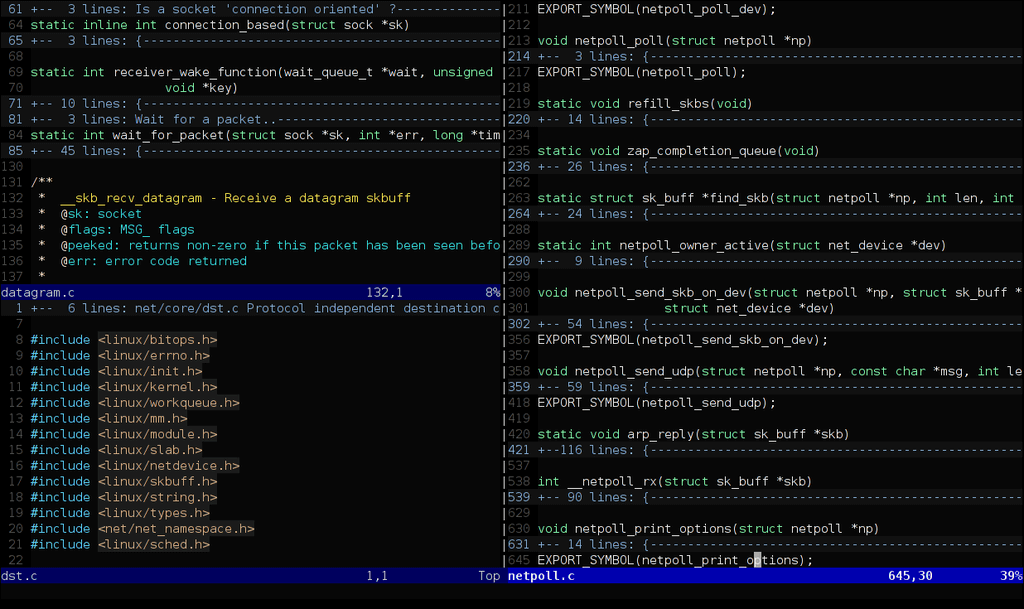
Vim is a software development tool that expands on the capabilities of the UNIX editor Vi. As a full-featured text editor, Vim comes equipped with advanced capabilities that help with efficient text editing while coding. It offers a seamless user experience and lightning-fast speed, thereby making it popular amongst developers.
Pricing
Free and open-source. However, all contributions to Vim development go to International Child Care Fund Holland, earning it the title of “charityware.”
Use Cases
Vim is primarily used for code writing, rapid development, and editing. That said, you can also use this software development tool for text editing and manipulation.
Key features
- It is a highly configurable, screen-based text editor (technically, not an IDE).
- Since it lacks a GUI, it makes use of keybindings (key shortcuts).
- Comes with Vimscript, a native Vim language that aids in the creation of custom automation and plugins for efficient workflows.
- Uses a distinct modal editing system assigned to specific tasks, such as normal mode for text manipulation and navigation, insert mode for text editing and insertion, and so on.
- Supports syntax highlighting for a variety of programming languages.
Pros
- Lightweight, open-source, free to use, and enjoys community support.
- High customization capabilities allow developers to tailor Vim to their specific needs, preferences, and styles.
- Has built-in features like syntax highlighting, search and replace, code folding, and regular expressions.
Cons
- Lacks an interactive GUI, which can be difficult to navigate by keyboard alone, especially for beginners.
- One has to have prior knowledge of the UNIX environment to utilize certain features.
10. Docker: For Unit-Based Software Development
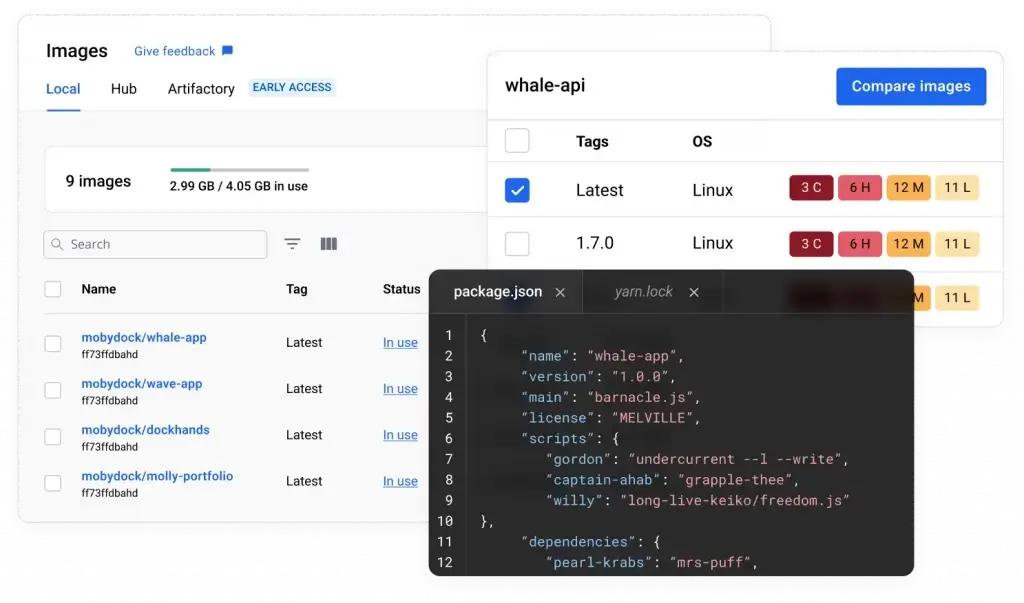
Docker is an agile software development tool that grants developers the freedom and flexibility to code in the language, framework, or architecture of their choice. It does so through a process called containerization, which packages the executable code with the operating system (OS) libraries and dependencies to make it platform-agnostic.
Pricing
- Personal: $0
- Pro: $5 per month
- Team: $9 per user per month (minimum 5 seats)
- Business: $24 per user per month (minimum 5 seats)
Use Cases
Docker is most well-known for the delivery of microservices and for building a microservice-based architecture.
Key features
- Build once, run anywhere – a Docker container will operate the same anywhere, regardless of its environment.
- Highly modular and lightweight application that can scale efficiently depending on the workload.
- Follows a distributed application model with a service-oriented architecture.
- The distributed nature of the application makes it more secure and reliable as failure or threat remains isolated.
- As an agile software development tool, it focuses on the development aspect and delinks operations.
Pros
- Software applications built using Docker will be highly consistent in terms of design, development, performance, maintenance, etc.
- It is far more efficient to create, test, and debug bite-sized code and use it to build a larger solution than the monolithic approach.
- Offers a high degree of security and threat neutralization.
Cons
- Managing large volumes of containers can get progressively difficult.
- Docker applications lack cross-platform compatibility.
11. Azure: Best Full-Cycle Software Development Tool
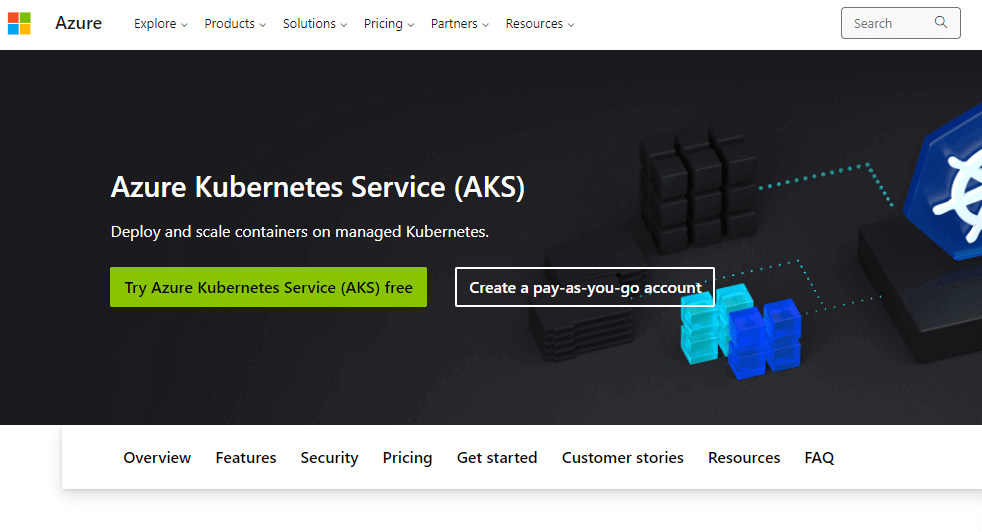
With nearly 2.5 million websites as Azure customers, it is a software development tool that needs no introduction. Backed by Microsoft, Azure is one of the best software development tools used to build, deploy, debug, and manage cloud-based web applications.
Pricing
Microsoft offers comprehensive Azure pay-as-you-go packages with high variability and flexibility. Contact support for an accurate estimate.
Use Cases
Microsoft Azure supports end-to-end serverless and full-stack software management. As a result, you can use it during any stage of the SDLC or throughout. Further, it packs tons of advanced features, and functionalities, such as Azure Kubernetes Services (AKS), which also makes it one of the best agile software development tools.
Key features
- It can be configured as Infrastructure-as-a-Service (IaaS), Platform-as-a-Service (PaaS), and Software-as-a-Service (SaaS).
- Hybrid cloud-native architecture, where organizations can choose on-prem infrastructure or hosted Azure development tools.
- Comprehensive cloud-based data storage and management services.
- Single-pane operations to get an overview of your hybrid environments.
Pros
- Grants developers absolute freedom to pick and choose the coding language and style of their choice.
- Access to 90+ compliance certifications, of which 50 are region or country-specific.
- Optimum blend of high security, availability, scalability, and cost-effectiveness.
Cons
- The feature-packed nature of the platform can make it seem overwhelming, especially for beginners.
- Requires expert management and platform proficiency to maximize returns.
How To Choose The Best Software Development Tools?
Choosing the best software development tools for your project can significantly impact its success. Here are several factors to consider when selecting software development tools:
- Project Requirements:
- Start by understanding the specific requirements of your project. Consider factors like the project’s size, complexity, and purpose (e.g., web app, mobile apps, desktop software, etc.).
- Technology Stack:
- Identify the programming languages, frameworks, and platforms you’ll be using. Your tools should be compatible with your chosen tech stack.
- Development Team:
- Consider the skills and preferences of your development team. Some tools may be better suited to the expertise of your team members.
- Budget:
- Evaluate your budget constraints. Some development tools are open-source or free, while others require a subscription or one-time purchase. Factor in licensing costs, if applicable.
- Scalability:
- Think about the scalability of the tool. Will it be suitable for your project’s growth and expansion? Does it support multiple developers working on the project simultaneously?
- Community and Support:
- Check if there is an active user community and good support for the tool. Active communities often mean more resources, plugins, and updates.
- Integration:
- Consider how well the tool integrates with other tools and systems you use, such as version control, project management, and deployment tools.
- Ease of Use:
- Evaluate the tool’s user interface and ease of use. A steep learning curve can slow down development initially.
Conclusion
Use the best software development tools shared above to cut short time-to-market, optimize resource utilization, develop a feature-rich solution, and increase ROI.
However, before committing to any of the software development tools, make sure that it can satisfy business requirements, and that your software projects team can work with it. After all, your software development team is as good as the software programming tools that they use – and vice versa!
👉 Take the smart move. Use Nifty as your software development planning tool instead of Jira. 🙌



